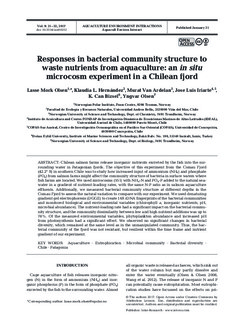| dc.contributor.author | Olsen, Lasse Mork | |
| dc.contributor.author | Hernandez, Klaudia | |
| dc.contributor.author | Ardelan, Murat Van | |
| dc.contributor.author | Iriarte, Jose Luis | |
| dc.contributor.author | Bizsel, Can | |
| dc.contributor.author | Olsen, Yngvar | |
| dc.date.accessioned | 2018-03-07T10:17:49Z | |
| dc.date.available | 2018-03-07T10:17:49Z | |
| dc.date.created | 2016-12-18T22:19:10Z | |
| dc.date.issued | 2017 | |
| dc.identifier.citation | Aquaculture Environment Interactions. 2017, 9 (1), 21-32. | nb_NO |
| dc.identifier.issn | 1869-215X | |
| dc.identifier.uri | http://hdl.handle.net/11250/2489169 | |
| dc.description.abstract | Chilean salmon farms release inorganic nutrients excreted by the fish into the surrounding water in Patagonian fjords. The objective of this experiment from the Comau Fjord (42.2° S) in southern Chile was to study how increased input of ammonium (NH4) and phosphate (PO4) from salmon farms might affect the community structure of bacteria in surface waters where fish farms are located. We used microcosms (35 l) with NH4-N and PO4-P added to the natural seawater in a gradient of nutrient-loading rates, with the same N:P ratio as in salmon aquaculture effluents. Additionally, we measured bacterial community structure at different depths in the Comau Fjord to assess the natural variation to compare with our experiment. We used denaturing gradient gel electrophoresis (DGGE) to create 16S rDNA fingerprints of the bacterial communities and monitored biological and environmental variables (chlorophyll a, inorganic nutrients, pH, microbial abundance). The nutrient-loading rate had a significant impact on the bacterial community structure, and the community dissimilarity between low and high nutrient additions was up to 78%. Of the measured environmental variables, phytoplankton abundance and increased pH from photosynthesis had a significant effect. We observed no significant changes in bacterial diversity, which remained at the same level as in the unmanipulated community. Thus, the bacterial community of the fjord was not resistant, but resilient within the time frame and nutrient gradient of our experiment. | nb_NO |
| dc.language.iso | eng | nb_NO |
| dc.publisher | Inter-Research | nb_NO |
| dc.rights | Navngivelse 4.0 Internasjonal | * |
| dc.rights.uri | http://creativecommons.org/licenses/by/4.0/deed.no | * |
| dc.title | Responses in the bacterial community structure to waste nutrients from aquaculture: an in situ microcosm experiment in a Chilean fjord | nb_NO |
| dc.type | Journal article | nb_NO |
| dc.type | Peer reviewed | nb_NO |
| dc.description.version | publishedVersion | nb_NO |
| dc.source.pagenumber | 21-32 | nb_NO |
| dc.source.volume | 9 | nb_NO |
| dc.source.journal | Aquaculture Environment Interactions | nb_NO |
| dc.source.issue | 1 | nb_NO |
| dc.identifier.doi | 10.3354/aei00212 | |
| dc.identifier.cristin | 1414745 | |
| dc.description.localcode | © The authors 2017. Open Access under Creative Commons by Attribution Licence. Use, distribution and reproduction are unrestricted. Authors and original publication must be credited. | nb_NO |
| cristin.unitcode | 194,66,25,0 | |
| cristin.unitcode | 194,66,10,0 | |
| cristin.unitname | Institutt for kjemi | |
| cristin.unitname | Institutt for biologi | |
| cristin.ispublished | true | |
| cristin.fulltext | original | |
| cristin.qualitycode | 1 | |

